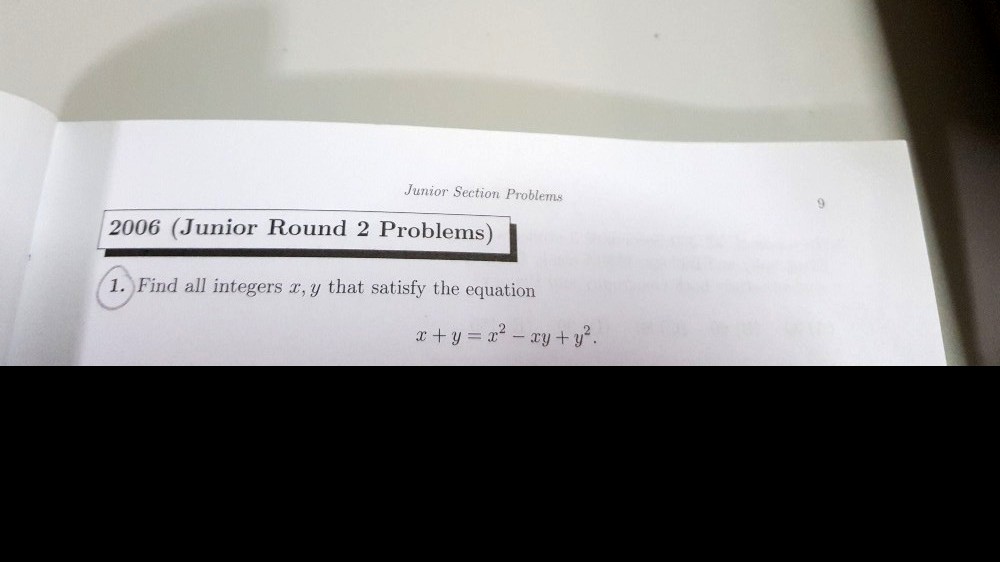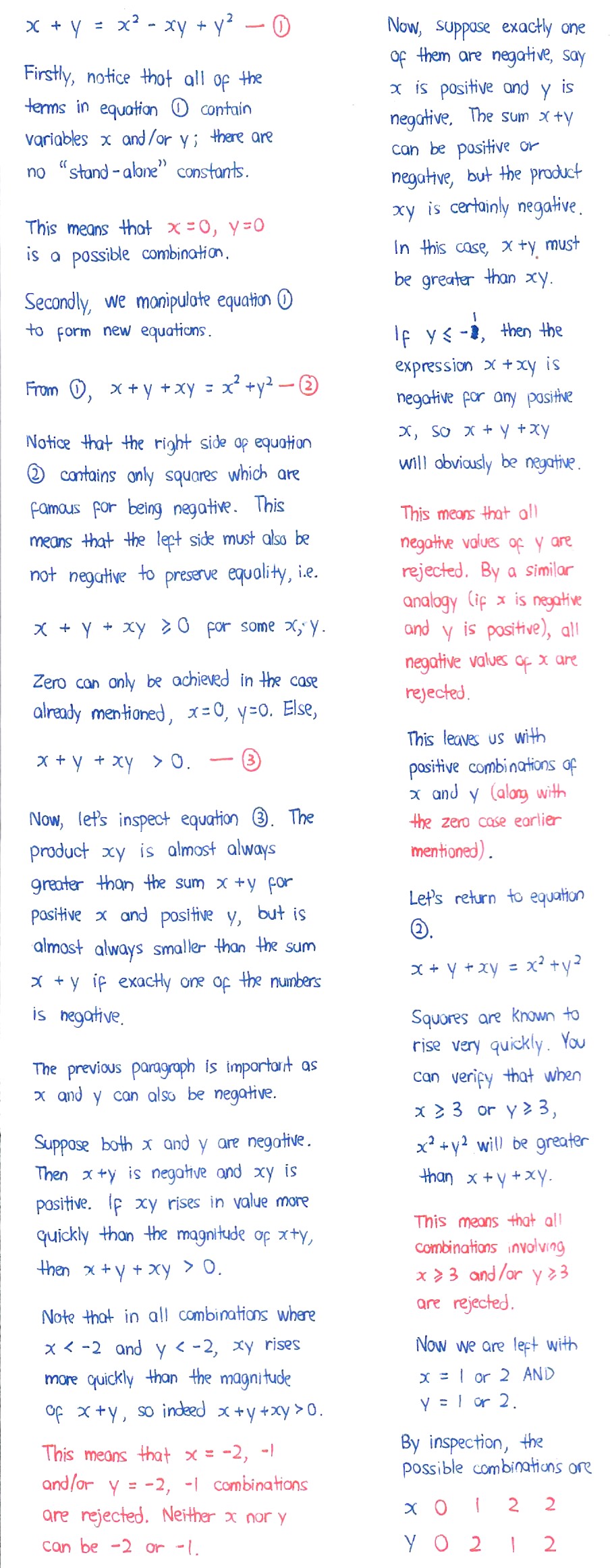Ask Singapore Homework?
Upload a photo of a Singapore homework and someone will email you the solution for free.

See 1 Answer
done
{{ upvoteCount }} Upvotes
clear
{{ downvoteCount * -1 }} Downvotes
Here are my workings, which involves very wordy explanations. I am unable to answer this question algebraically (at least for the time being), so I have resorted to logical approaches to do this question. Hopefully my answer and explanations make sense and you can understand my explanations.
Date Posted:
4 years ago
You can also try and consider other approaches. One possible way is to consider even and odd numbers.
If both numbers are odd, then the left hand side x + y is the sum/difference of two odd numbers which is an even number, while the right hand side x2 - xy + y2 is the sum/difference of three odd numbers which is an odd number. Of course both sides of the equation are not equal as a result.
We can reject all cases where BOTH x and y are odd as a result.
If both numbers are odd, then the left hand side x + y is the sum/difference of two odd numbers which is an even number, while the right hand side x2 - xy + y2 is the sum/difference of three odd numbers which is an odd number. Of course both sides of the equation are not equal as a result.
We can reject all cases where BOTH x and y are odd as a result.
Correction to one section of the explanations on the right half of the page.
...the expression x + xy is non-positive for any positive x...
Also, I missed out the case when BOTH x and y are -3 and smaller.
However, this is easily resolved, since x + y + xy when both x and y are positive is always greater than x + y + xy when both x and y are negative, and even then, x2 + y2 wins x + y + xy outright for all x and/or y >= 3.
Remember that x2 + y2 remains a large positive number even if x and y are both -3 or smaller.
Summing this up, x2 + y2 > x + y + xy for all the cases where BOTH x and y are greater than 2 or BOTH x and y are smaller than -2.
Recall that we already rejected the cases involving x and/or y being -2 or -1 earlier, so add this to the list and we have rejected all cases where x and/or y are negative.
...the expression x + xy is non-positive for any positive x...
Also, I missed out the case when BOTH x and y are -3 and smaller.
However, this is easily resolved, since x + y + xy when both x and y are positive is always greater than x + y + xy when both x and y are negative, and even then, x2 + y2 wins x + y + xy outright for all x and/or y >= 3.
Remember that x2 + y2 remains a large positive number even if x and y are both -3 or smaller.
Summing this up, x2 + y2 > x + y + xy for all the cases where BOTH x and y are greater than 2 or BOTH x and y are smaller than -2.
Recall that we already rejected the cases involving x and/or y being -2 or -1 earlier, so add this to the list and we have rejected all cases where x and/or y are negative.
thank you for answering!
Algebraic method :
x + y = x² - xy + y²
x² - x + y² - y - xy = 0
x² - (1 + y)x + y(y - 1) = 0
x² + (-y - 1)x + y(y - 1) = 0
For real roots, b² - 4ac ≥ 0
(-y - 1)² - 4(1)(y)(y - 1) ≥ 0
y² + 2y + 1 - 4y² + 4y ≥ 0
3y² - 6y - 1 ≤ 0
y² - 2y - ⅓ ≤ 0
(y - 1)² ≤ 4/3
-2/√3 ≤ y - 1 ≤ 2/√3
1 - 2/√3 ≤ y ≤ 1 + 2/√3
- 0.1547 ≤ y ≤ 2.1547
Since y has to be integer,
0 ≤ y ≤ 2
so y = 0, 1 or 2
when y = 0, x² - x = 0 → x = 0 or x = 1
when y = 1, x² - 2x = 0→ x = 0 or x = 2
when y = 2, x² - 3x + 2 = 0
(x - 2)(x - 1) = 0 → x = 2 or x = 1
So possible integer pairs for (x,y) are (0,0), (0,1), (1,0),(1,2), (2,1) (2,2)
Notice that y and x are interchangeable. You could also let x be the constant and y be the variable and get the same result
x + y = x² - xy + y²
x² - x + y² - y - xy = 0
x² - (1 + y)x + y(y - 1) = 0
x² + (-y - 1)x + y(y - 1) = 0
For real roots, b² - 4ac ≥ 0
(-y - 1)² - 4(1)(y)(y - 1) ≥ 0
y² + 2y + 1 - 4y² + 4y ≥ 0
3y² - 6y - 1 ≤ 0
y² - 2y - ⅓ ≤ 0
(y - 1)² ≤ 4/3
-2/√3 ≤ y - 1 ≤ 2/√3
1 - 2/√3 ≤ y ≤ 1 + 2/√3
- 0.1547 ≤ y ≤ 2.1547
Since y has to be integer,
0 ≤ y ≤ 2
so y = 0, 1 or 2
when y = 0, x² - x = 0 → x = 0 or x = 1
when y = 1, x² - 2x = 0→ x = 0 or x = 2
when y = 2, x² - 3x + 2 = 0
(x - 2)(x - 1) = 0 → x = 2 or x = 1
So possible integer pairs for (x,y) are (0,0), (0,1), (1,0),(1,2), (2,1) (2,2)
Notice that y and x are interchangeable. You could also let x be the constant and y be the variable and get the same result
Hmmm...I did not think of putting y as a ‘constant’ within the discriminant b2 - 4ac.
This method is more suitable for upper secondary students though, considering that the student is from Sec 2 (even though the name of the paper suggests something like math Olympiad standard).
This method is more suitable for upper secondary students though, considering that the student is from Sec 2 (even though the name of the paper suggests something like math Olympiad standard).
Yup, I inferred from the '2006 Junior Round 2' that it was a Math Olympiad question. Anyway for Olympiad they're expected to use techniques beyond what they're currently taught in the normal curriculum
Alternatively, we split it into two cases.
① x = y
Then x + x = x² - x² + x²
2x = x²
x² - 2x = 0
x = 0 or x = 2
Parings are (0,0) and (2,2)
② y > x
Since we want integer values of x and y,
let y = x + n, where n is a positive integer
x + x + n = x² - x(x + n) + (x + n)²
2x + n = x² - x² - nx + x² + 2nx + n²
x² + nx + n² - 2x - n = 0
x² + (n - 2)x + n(n - 1) = 0
For real roots, b² - 4ac ≥ 0
(n - 2)² - 4(1)(n)(n - 1) ≥ 0
n² - 4n + 4 - 4n² + 4n ≥ 0
3n² ≤ 4
n² ≤ 4/3
-2/√3 ≤ n ≤ 2/√3
But as n is a positive integer, n = 1
Then x² - x = 0
x = 0 or 1
So y = 1 or 2
Pairings are (0,1) and (1,2)
Notice that x and y are interchangeable, we can get the same result when we let x > y and x = y + n , n is a positive integer
① x = y
Then x + x = x² - x² + x²
2x = x²
x² - 2x = 0
x = 0 or x = 2
Parings are (0,0) and (2,2)
② y > x
Since we want integer values of x and y,
let y = x + n, where n is a positive integer
x + x + n = x² - x(x + n) + (x + n)²
2x + n = x² - x² - nx + x² + 2nx + n²
x² + nx + n² - 2x - n = 0
x² + (n - 2)x + n(n - 1) = 0
For real roots, b² - 4ac ≥ 0
(n - 2)² - 4(1)(n)(n - 1) ≥ 0
n² - 4n + 4 - 4n² + 4n ≥ 0
3n² ≤ 4
n² ≤ 4/3
-2/√3 ≤ n ≤ 2/√3
But as n is a positive integer, n = 1
Then x² - x = 0
x = 0 or 1
So y = 1 or 2
Pairings are (0,1) and (1,2)
Notice that x and y are interchangeable, we can get the same result when we let x > y and x = y + n , n is a positive integer






